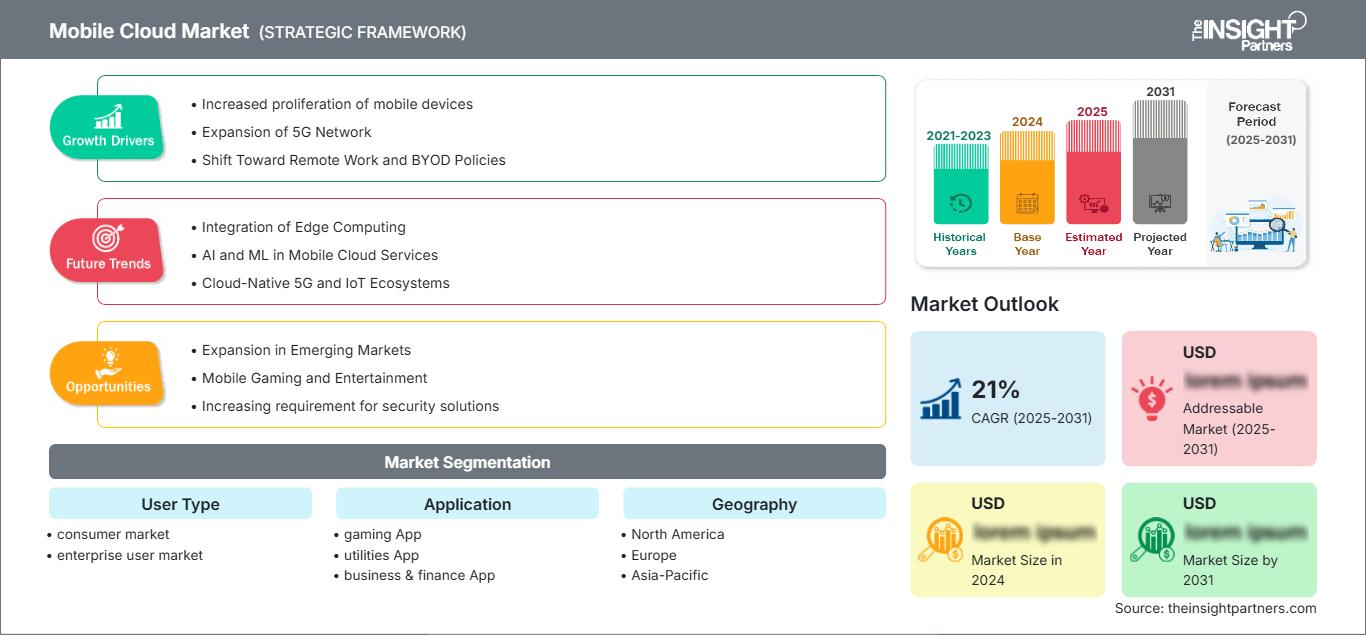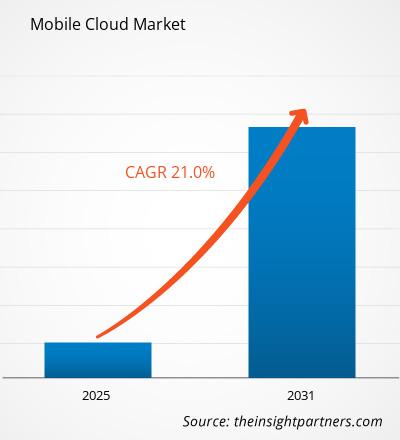Le marché du cloud mobile devrait atteindre 87,05 milliards de dollars américains d'ici 2031. Il devrait enregistrer un TCAC de 19,3 % entre 2025 et 2031.
Le rapport sur le marché du cloud mobile comprend une analyse par type d'utilisateur et par application. L'analyse globale est ensuite ventilée au niveau régional et par principaux pays. Le rapport présente la valeur en dollars américains pour les analyses et segments mentionnés ci-dessus.
Objectif du rapport
Le rapport sur le marché du cloud mobile, réalisé par The Insight Partners, vise à décrire le paysage actuel et la croissance future, les principaux facteurs de croissance, les défis et les opportunités. Cela permettra d'éclairer divers acteurs économiques, tels que :
- Fournisseurs de technologies/Fabricants : Pour comprendre l'évolution de la dynamique du marché et identifier les opportunités de croissance potentielles, afin de prendre des décisions stratégiques éclairées.
- Investisseurs : Pour réaliser une analyse approfondie des tendances concernant le taux de croissance du marché, les projections financières et les opportunités tout au long de la chaîne de valeur.
- Organismes de réglementation : Pour encadrer les politiques et les activités du marché afin de minimiser les abus, préserver la confiance des investisseurs et garantir l'intégrité et la stabilité du marché.
Segmentation du marché du cloud mobile par type d'utilisateur
- Marché grand public
- Marché des entreprises
Application
- Application de jeux
- Application utilitaire
- Application commerciale et financière
- Application de productivité
- Application de santé
- Application de divertissement
- Application de voyage et de navigation
- Application éducative
- Application de réseau social et autres
Vous bénéficierez d’une personnalisation sur n’importe quel rapport - gratuitement - y compris des parties de ce rapport, ou une analyse au niveau du pays, un pack de données Excel, ainsi que de profiter d’offres exceptionnelles et de réductions pour les start-ups et les universités
Marché du cloud mobile: Perspectives stratégiques

- Obtenez les principales tendances clés du marché de ce rapport.Cet échantillon GRATUIT comprendra une analyse de données, allant des tendances du marché aux estimations et prévisions.
Facteurs de croissance du marché du cloud mobile
- Prolifération accrue des appareils mobiles : L’utilisation des smartphones, des tablettes et de l’Internet des objets accélère considérablement la croissance du marché du cloud mobile. Avec une dépendance croissante aux appareils mobiles pour les activités personnelles et professionnelles, la demande de services cloud augmente. Les solutions cloud doivent être évolutives et sécurisées, des exigences fondamentales auxquelles répond rapidement la facilité de synchronisation entre les plateformes, combinée à la pénétration croissante de l’Internet mobile.
- Déploiement du réseau 5G : Le déploiement mondial du réseau 5G révolutionne en profondeur les capacités du cloud mobile. La vitesse élevée, la faible latence et la fiabilité accrue de la 5G permettent un traitement en temps réel et des performances optimales pour les applications mobiles cloud. Les entreprises peuvent également déployer des applications cloud plus complexes grâce à la 5G, ce qui favorisera l’innovation dans les secteurs de la santé, de l’éducation et de l’industrie.
- Évolution vers le télétravail et les politiques BYOD : La tendance croissante au travail à distance et à l’utilisation d’appareils personnels (BYOD) stimule la croissance des clouds mobiles. Les entreprises adoptent de plus en plus les technologies de cloud mobile pour accompagner leurs équipes dispersées, car chacun peut désormais accéder en toute sécurité aux applications et données professionnelles depuis n’importe quel appareil personnel. Les solutions de cloud mobile garantissent productivité, collaboration et sécurité renforcée grâce à des bases de données centralisées, une synchronisation en temps réel et des contrôles d’accès stricts. L’essor du télétravail, accéléré par la pandémie de COVID-19, a encore accentué l’importance du cloud mobile pour la continuité et la flexibilité des activités. Face à l’importance accrue accordée à la mobilité des employés et à l’efficacité opérationnelle, l’adoption des solutions de cloud mobile devrait progresser.
Tendances futures du marché du cloud mobile
- Intégration du Edge Computing : L’Edge Computing, qui s’impose comme une tendance majeure dans l’évolution des services de cloud mobile, constitue un levier important. L'informatique de périphérie (Edge Computing) consiste à traiter les données au plus près de leur source, c'est-à-dire directement sur l'appareil mobile, plutôt que de s'appuyer sur des serveurs cloud centralisés. La latence est ainsi considérablement réduite et les applications temps réel, telles que les véhicules autonomes, l'automatisation industrielle et les villes intelligentes, bénéficient de performances améliorées pour les tâches critiques.
- IA et apprentissage automatique dans les services de cloud mobile : L'IA et l'apprentissage automatique vont transformer le cloud mobile et permettre aux entreprises de développer des applications intelligentes et d'automatiser de nombreuses opérations pour divers processus métier. Les fournisseurs de cloud intégreront de plus en plus l'IA et l'apprentissage automatique pour des fonctionnalités telles que l'analyse en temps réel, la maintenance prédictive et la gestion intelligente des données. L'IA, combinée au cloud, ne fera qu'amplifier les innovations dans les secteurs de la santé, de la finance et du marketing.
- Écosystèmes 5G et IoT natifs du cloud : Cette convergence des technologies 5G de première génération, de l'IoT et du cloud mobile donnera naissance à un nouvel écosystème de communication et d'échange de données fluides entre appareils. Leurs réseaux à haut débit et faible latence seront de la 5G, conçus pour faciliter le fonctionnement de l'IoT dans des environnements réels, des maisons intelligentes aux voitures connectées. Bien entendu, il s'agira du cloud, assurant ainsi le traitement, le stockage et l'analyse des milliards de signaux émis par les appareils compatibles IoT, le développement de nouvelles villes intelligentes, les systèmes de santé connectés et les solutions de transport de nouvelle génération.
Opportunités du marché du cloud mobile
- Expansion sur les marchés émergents : La pénétration croissante des smartphones et la baisse du coût d'accès à l'internet mobile dans les économies émergentes offriront les meilleures opportunités de croissance pour le cloud mobile. Les entreprises pourront pénétrer les marchés sous-exploités en fournissant des services cloud optimisés pour une utilisation mobile à des coûts nettement inférieurs, favorisant ainsi la transformation numérique et la croissance économique. Une infrastructure cloud localisée et des solutions adaptées aux besoins régionaux ouvriront de nouvelles sources de revenus pour les fournisseurs de services cloud.
- Jeux et divertissement mobiles : Le jeu mobile est un secteur en pleine croissance, notamment grâce au cloud gaming, qui connaît une forte expansion et est stimulé par la 5G et le cloud computing. Des services comme Microsoft xCloud et Google Stadia vont révolutionner l'accès aux jeux haute performance sur appareils mobiles, en s'affranchissant du matériel coûteux. Les services de streaming vidéo et musical, intégrés aux plateformes de divertissement mobile dans le cloud, connaîtront également une croissance, portée par la recherche de solutions évolutives capables de gérer l'augmentation du trafic généré par les créateurs de contenu.
- Besoins croissants en matière de sécurité : Avec la dépendance croissante aux services cloud mobiles, la demande de solutions de sécurité plus robustes s'accroît. Le stockage et l'accès aux données et applications sensibles sur les appareils mobiles augmentent le risque de cyberattaques. Cette demande devrait encore augmenter, les utilisateurs étant de plus en plus soucieux de la sécurité dans le cloud mobile. De ce fait, les entreprises spécialisées dans ce domaine (chiffrement, authentification multifacteur, gestion des identités) se multiplient.
Marché du cloud mobile
Les analystes de The Insight Partners ont analysé en détail les tendances régionales et les facteurs influençant le marché du cloud mobile tout au long de la période de prévision. Cette section aborde également les segments et la répartition géographique du marché de la gestion des troubles du rythme cardiaque en Amérique du Nord, en Europe, en Asie-Pacifique, au Moyen-Orient et en Afrique, ainsi qu'en Amérique du Sud et centrale.
Portée du rapport sur le marché du cloud mobile
| Attribut de rapport | Détails |
|---|---|
| Taille du marché en 2024 | US$ XX Billion |
| Taille du marché par 2031 | US$ 87.05 Billion |
| TCAC mondial (2025 - 2031) | 19.3% |
| Données historiques | 2021-2023 |
| Période de prévision | 2025-2031 |
| Segments couverts |
By Type d'utilisateur
|
| Régions et pays couverts | Amérique du Nord
|
| Leaders du marché et profils d'entreprises clés |
|
Densité des acteurs du marché du cloud mobile : comprendre son impact sur la dynamique commerciale
Le marché du cloud mobile connaît une croissance rapide, portée par la demande croissante des utilisateurs finaux, elle-même alimentée par l'évolution des préférences des consommateurs, les progrès technologiques et une meilleure connaissance des avantages du produit. Face à cette demande grandissante, les entreprises élargissent leur offre, innovent pour répondre aux besoins des consommateurs et tirent parti des tendances émergentes, ce qui stimule davantage la croissance du marché.

- Obtenez le Marché du cloud mobile Aperçu des principaux acteurs clés
Points clés de la vente
- Couverture exhaustive : Ce rapport analyse en détail les produits, services, types et utilisateurs finaux du marché du cloud mobile, offrant ainsi une vision globale.
- Analyse d'experts : Ce rapport repose sur une connaissance approfondie du secteur et des analystes.
- Informations actualisées : Grâce à sa couverture des informations et tendances les plus récentes, ce rapport garantit la pertinence de vos analyses.
- Options de personnalisation : Ce rapport peut être personnalisé pour répondre aux besoins spécifiques de chaque client et s'adapter parfaitement à ses stratégies commerciales.
Ce rapport d'étude de marché sur le cloud mobile peut donc vous aider à décrypter et comprendre le contexte sectoriel et les perspectives de croissance. Malgré quelques points à améliorer, les avantages de ce rapport l'emportent généralement sur les inconvénients.
- Analyse historique (2 ans), année de base, prévision (7 ans) avec TCAC
- Analyse PEST et SWOT
- Taille du marché Valeur / Volume - Mondial, Régional, Pays
- Industrie et paysage concurrentiel
- Ensemble de données Excel
Rapports récents
Rapports connexes
Témoignages
Raison d'acheter
- Prise de décision éclairée
- Compréhension de la dynamique du marché
- Analyse concurrentielle
- Connaissances clients
- Prévisions de marché
- Atténuation des risques
- Planification stratégique
- Justification des investissements
- Identification des marchés émergents
- Amélioration des stratégies marketing
- Amélioration de l'efficacité opérationnelle
- Alignement sur les tendances réglementaires






















 Obtenez un échantillon gratuit pour - Marché du cloud mobile
Obtenez un échantillon gratuit pour - Marché du cloud mobile